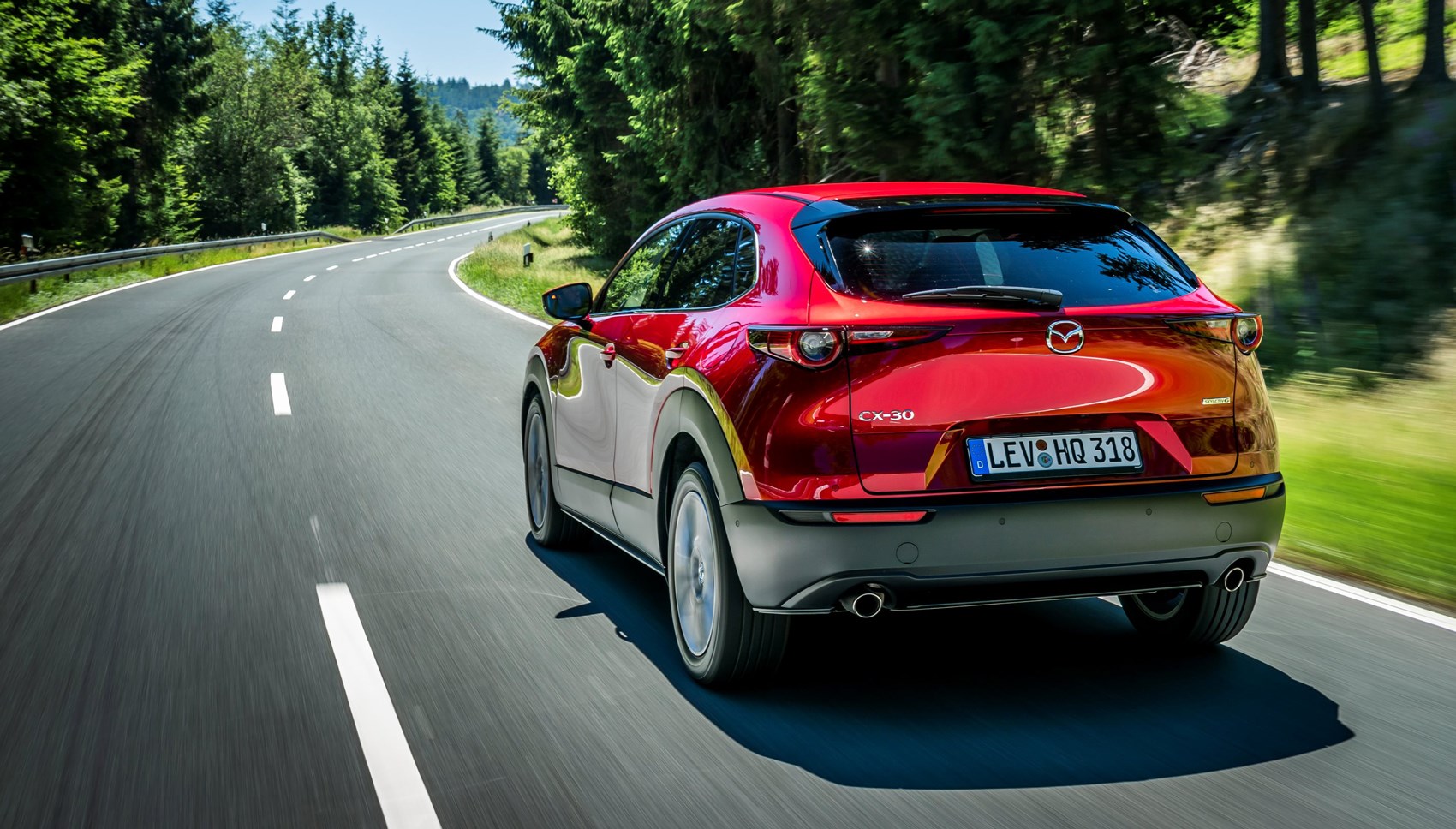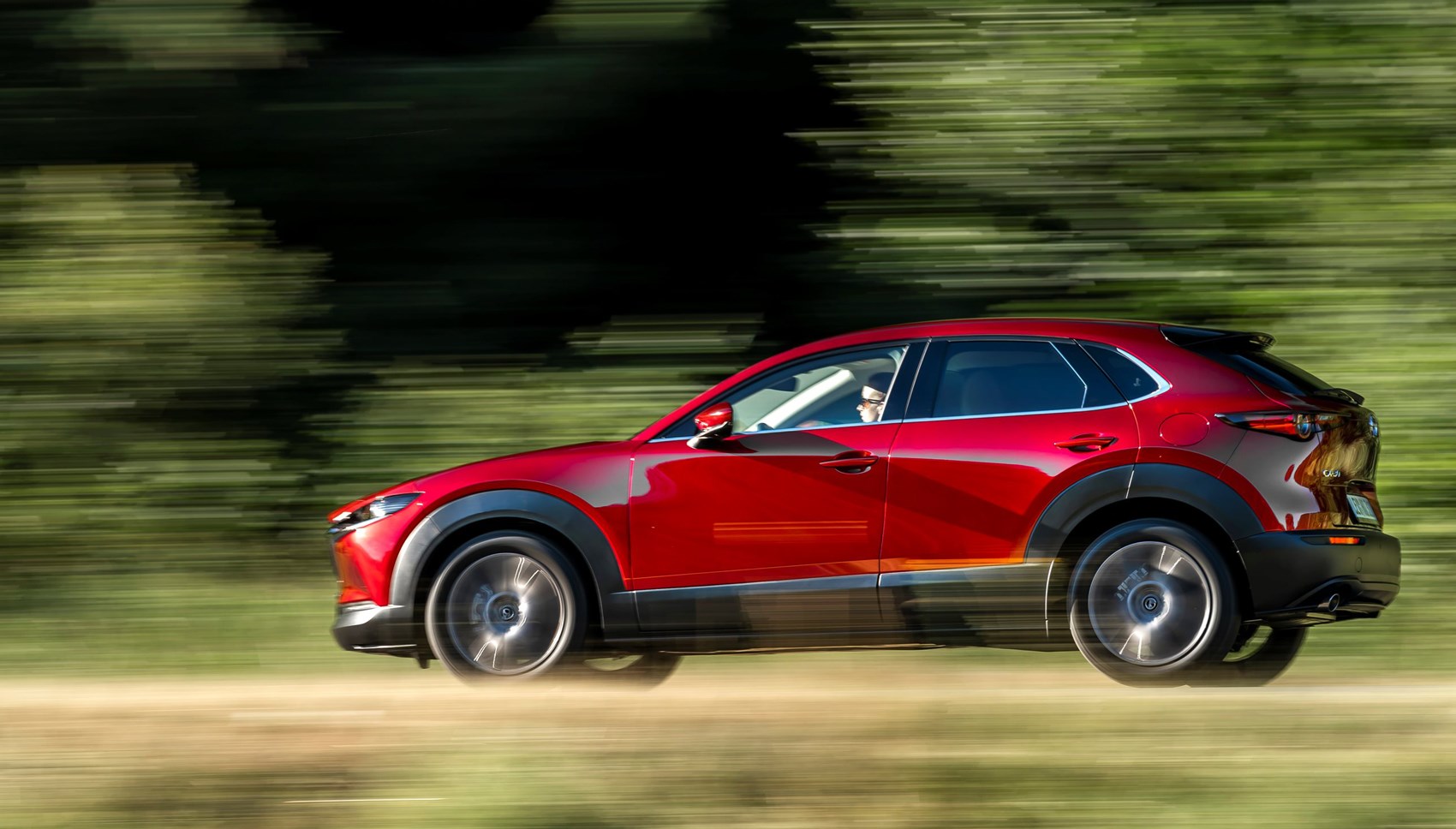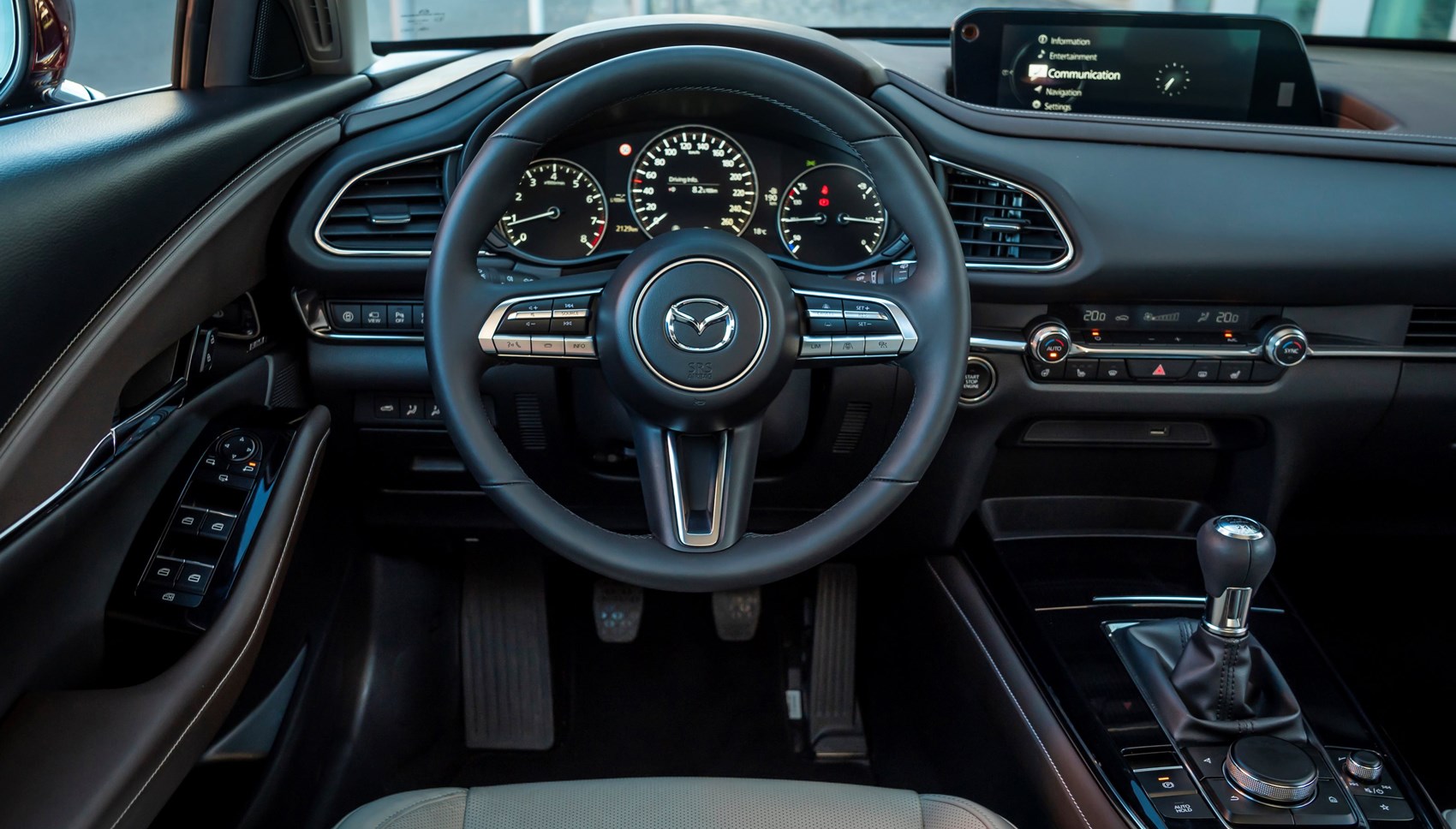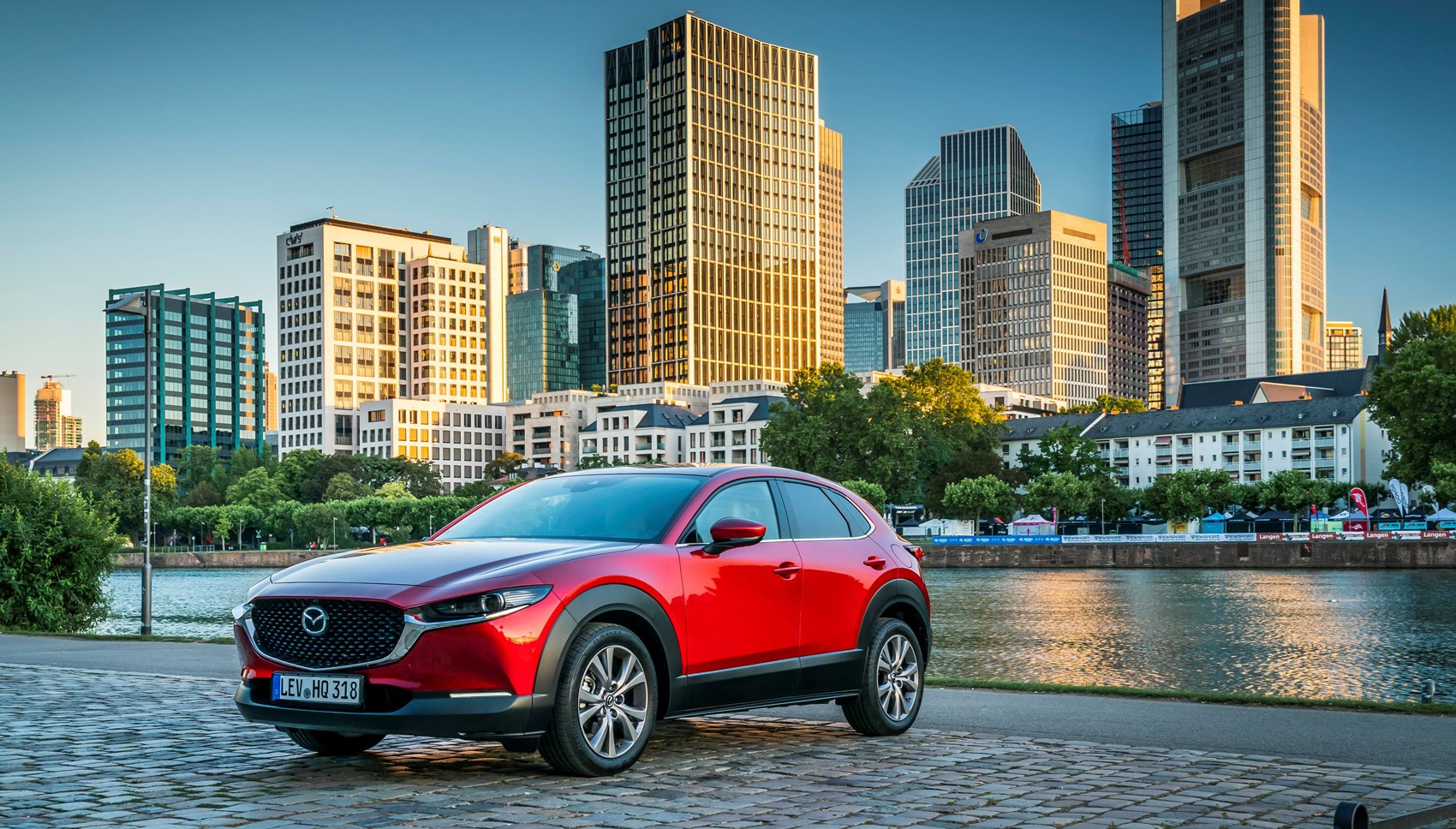► New CX-30 SUV driven
► Just a taller Mazda 3 hatch?
► On UK sale in December 2019
Mazda’s crossover range has now grown from two to three with the introduction of this: the new CX-30. It’s designed to sit between the CX-3 and CX-5 but, since the CX-4 badge already exists for the Chinese market, Mazda had to give this one a different name.
It follows on from the updated Mazda 3 hatch, and steals its powertrain and technology underpants, too. Prices haven’t been confirmed yet; we’ll find out how much it’ll cost in the autumn of 2019, before it goes on sale in December. Expect it to weigh in around £2000-£3000 more than an equivalent Mazda 3 hatch.
What engines does the Mazda CX-30 get?
There’s a 120bhp 2.0-litre naturally-aspirated petrol (badged Skyactiv-G), Mazda’s new Spark Controlled Compression Ignition petrol engine (called Skyactiv-X) and a 114bhp 2.0-litre turbodiesel (Skyactiv-D) available from launch when the car arrives in the UK. We drove a petrol auto and a diesel manual – both front-wheel drive (all-wheel drive is an option).

The regular petrol is smooth and well insulated in town, but it lacks any real punch, as Mazda continues to avoid sticking turbos on its cars. While it revs freely – something Mazda has put considerable effort into making a characteristic of its whole engine range – the lack of torque just makes this 2.0-litre engine feel breathless and strained when you apply more revs to overtake.
As for the diesel, we would have suggested you go for that but the engine isn’t coming to the UK market. For European buyers, it just has a little more punch lower down in the rev range and more flexibility in day-to-day use. The trade-off is that it’s quite gruff getting up to speed, but it also means your CX-30 can pull the skin off a rice pudding.
What about the Skyactiv-X engine?
Mazda’s new 2.0-litre normally aspirated engine (badged Skyactiv-X) uses a clever compression ignition system that is supposed to give it petrol-like performance and diesel-esque frugality. It certainly feels less breathless than the Skyactiv-G engine. But it doesn’t feel as fast as 180hp should do. We applaud Mazda for going against the grain, and forging ahead with normally-aspirated petrol engines. But it’s just not all that brilliant.
It fires into life with the gruffness of a diesel, and settles into a more petrol-like hum eventually. Peak power comes in at a heady 6,000 rpm, so the engine needs revving hard to get any momentum. This sounds like it’s well suited to driving enthusiasts who like to rev the nuts off things (we mean, who doesn’t?) but power delivery is not as linear as a regular naturally-aspirated petrol engine. There are slight steps in the rev range that makes it feel hesitant. Once you’re past 6,000 rpm it’s pretty sweet, but we bet that most crossover drivers will not want to do that too often.
The most fuel efficient Skyactiv-X records a WLTP figure of 45.6mpg. This is for the FWD manual version, and our test drive route on motorways and A-Roads would suggest this figure is true to form.
How does the CX-30 drive?
Would you be shocked if we said it was a lot like the 3 hatch? All round, it’s a decent driving experience. The steering is precise and generously weighted – the latter point many crossovers blindly ignore – and the manual gearbox has a very satisfying shift, courtesy of a rather stubby gearknob. The six-speed automatic option is smooth enough and responsive on downshifts when you prod the throttle, but we’d take the manual in a heartbeat.

Ride and refinement are good, too, with a generally softer ride than a Mazda 3 hatch. Even on the largest wheels, the ride is comfortable and damped well to cope with some rather serious potholes. That does, however, translate into noticeable body roll in faster corners.
What’s the interior like?
Well, along with the well-resolved (for an SUV) exterior design, the interior is a knock-out. Material quality truly rivals an Audi Q2’s and betters the likes of the BMW X1 by some margin, let alone more mainstream contenders like the Ford EcoSport and Vauxhall Mokka X. It’s a lovely place to sit.
Not only that, but the amount of standard equipment on basic Mazda CX-30 crossovers is mighty impressive. Automatic emergency braking, high-beam assist, blindspot monitoring with rear cross traffic alert, lane-departure warning and lane keep, traffic sign recognition and adaptive cruise control are all standard… Take that, premium German marques!

Mazda has tried to keep things as simple as possible in terms of managing all this tech, with the high-res central screen controlled by a simple rotary wheel on the centre console. As other brands do away with such useful devices (we’re looking at you, Audi), Mazda maintains course.
Can I use it as a family car?
This is where the CX-30 falls down a bit. Headroom in the rear is good for tall adults, but legroom isn’t quite as generous. The rear window pillars are quite big – it might not be as obstructive as in a Mazda 3 hatchback, but it darkens the rear half of the car considerably.
The 430-litre boot area is useful and has some underfloor storage, but is dwarfed by rivals like the BMW X1 and even the ancient and notoriously impractical Mercedes GLA. Look elsewhere if you regularly fill your boot up.

Mazda CX-30: verdict
In a crowded segment, the CX-30 makes a decent case for itself. Mazda’s design department continues to crank out good-looking cars, its interior rivals the best in the sector and it will engage you a little more than your run-of-the-mill small SUV.
Does all of this sound good to you? Unless you need the taller ride height or slightly bigger boot, the Mazda 3 hatch does all of this and handles a little more tidily, too.
More Mazda reviews by CAR magazine